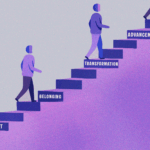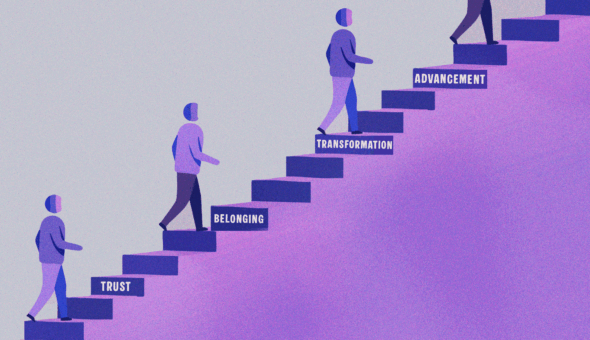In Caleb John’s glovebox, nestled between pipe thread sealant and a crumpled pack of gum, sits a folded alumni magazine. Not because he’s sentimental. Not because he’s short on floor mats. But because something in the publication from Scotch College Adelaide stuck: a story about someone like him. A tradesperson who built something from the ground up.
“It’s the only alumni thing I get that doesn’t feel like a cash grab,” said John, who runs a family-owned plumbing and air conditioning business in Australia.
For alumni across industries and time zones, a college or university magazine, when done right, isn’t just a throwback. It’s a reminder. A signal. A still point in a world of scrolls.
“Once you have someone’s attention, you have to make it count,” said Sonja Sherwood, Executive Director of Internal Communications and Publications at Drexel University. “Don’t get all the way into a person’s living room only to bore them, feed them a line or constantly hold out your hand. Inspire, entertain, serve. Make them proud to be connected to your institution and curious about what’s next. It’s a long game. It’s a relationship.”
A Tangible Thread: How Print Still Connects in a Digital Age
Despite the digital tide, print alumni magazines still hold their ground. Page counts have shrunk. Publishing frequency has decreased. The ethics of sustainability raise questions. Content strategies now span a broader ecosystem (e.g., email, social media, video).
And yet, print still holds power. Reader surveys consistently show a “U” curve: Older alumni value the physical piece, and younger alumni crave something tangible in their digital lives, said Erin Peterson, founder of Capstone Communications.
“If you’re trying to cut through today’s crowded, noisy media landscape,” Sherwood said, “there’s still nothing like the impact of a beautifully designed publication that lands in someone’s home. It’s premium, it’s permissioned and it invites people to linger, even pass it along.”
“Print used to be the primary way schools stayed in touch,” Peterson adds. “Now, it’s the premium way. That means it must showcase the very best: storytelling, photography, design, and experience. A great magazine earns its spot on the coffee table and in readers’ lives.”
Authenticity Over Applause: Real Stories That Resonate
To be worth that space, today’s alumni magazines have evolved. Once a glossy chronicle of campus happenings and donor lists, they’re becoming something more essential: a curated, credible space where alumni see themselves, not just in past glory but in present grit.
That means going beyond gala recaps and honorary degrees. Readers want to see blue-collar feats and beta-test failures alongside academic milestones and startup wins. They want a voice that feels less like LinkedIn and more like a lived-in journal.
“Don’t get all the way into a person’s living room only to bore them, feed them a line or constantly hold out your hand.” — Sonja Sherwood, Drexel University
Thomas Franklin, founder and CEO of a fintech startup and an alumnus of Aarhus Business College in Denmark, puts it this way: “Alumni magazines don’t die because of digital. They die when they stop delivering identity. The best ones actually remind. They remind you who you were when you still believed big things were possible. If the issue doesn’t make me pause, relate, or remember, it’s just branded wallpaper.”
Adam Klein, a Santa Clara University graduate and managing director at New Ventures West, said he still reads his alumni magazine when it feels written with him in mind, not at him.
“That difference shows up in the details,” he said. “I pick up an alumni magazine to feel who is actually doing the work — what failed, what got rebuilt, who left and came back.”
The glossy donor spreads?
“That issue went straight to the recycling bin,” he said. But the next one, which featured a story about an alum who left their industry to open a food co-op in a rural town? “I read it twice. The real draw is honesty, not polish.”
Print’s New Power: Trust, Identity and Long-Term Connection
That emotional tug (i.e., the power to reconnect readers with their past selves and future potential) gives alumni magazines a unique potency. But to unlock that potential, editors must take cues from the real world.
Nathan Mathews, an alumnus of the University of Pennsylvania, wants stories with teeth.
“I open mine with a coffee and a Sharpie. I mark it up like a whiteboard,” he said. He wants to read about fellow alumni who failed, pivoted, rebuilt. Not glossy arcs, but stories with callouses. “If editors want to survive the next five years, they better start treating alumni stories like product updates.”
Holly Neumann, editor of the University of Tampa’s UT Journal, knows the value of both resonance and relevance.
“Nostalgia is big,” she said. “I get emails from alumni thanking me for a trip down memory lane.”
But she works to preserve editorial authenticity while aligning with the university’s brand. When tasked with covering yet another new campus building, Neumann and her team took a creative approach: they embedded themselves in the space for 24 hours to capture how it was actually used. A common complaint? The slow elevators.
“It was a detail we would normally not want to include, but it felt inauthentic to ignore it,” she said. Instead, they included a lighthearted illustration of a crowded elevator and let readers draw their conclusions. “We put the story on the cover, and it has received plenty of attention — a good example of good storytelling that also checks a box.”
That kind of narrative intimacy helps alumni feel plugged in — not just to a place, but to a pulse.
Handwritten, Not Harvested: What Readers Actually Want
Dubrulle Culinary School alumna Barbara Robinson, whose Vancouver-area company builds large-scale weather structures often in remote, offline environments, sees the value of print not just as a format, but as a necessity.
“A well-printed alumni magazine feels more like a piece of equipment than a piece of marketing,” she said. “For folks who have lived and worked 3,000 meters above sea level, often without connectivity for 10 days at a time, this kind of communication is a rare anchor.”
That sense of anchoring is echoed by Benjamin Tom, a utility specialist and alum of California State University of Northridge. He’s not interested in fluff; he wants data, diagrams, charts. Once, he said, he saved a 2016 issue of CSUN Magazine because it mentioned grid decentralization in Tasmania.
“The real issue is not the medium but the editorial discipline,” he said. “Are they actually curating useful updates? Or is it just another roundup of who donated what, with a side of nostalgia and cafeteria flashbacks?”
“Print used to be the primary way schools stayed in touch. Now, it’s the premium way. — Erin Peterson, Capstone Communications
For other alumni, that same feeling of connection comes from seeing their community reflected in print, offering a moment to pause, reflect and reconnect. Last month’s issue of Pace Magazine featured a former study group partner of Andrew Lokenauth, a 2010 graduate of Pace University. His classmate had launched a successful tech startup, and the founder of The Finance Newsletter said, seeing his classmate’s story laid out in the alumni mag’s glossy pages felt way more meaningful than scrolling past a LinkedIn update.
“I regularly use the magazine’s content as conversation starters in professional settings,” Lokenauth said. “A recent article about sustainability initiatives on campus helped me connect with another Pace grad at an industry conference, leading to a valuable business partnership.”
Resilience in Ink: Why Print Still Earns Its Spot
What readers are asking for, across the board, is substance. Applied resilience. Real voices. A move away from monoculture storytelling and toward something more plural, grounded and useful. And in a print landscape often declared dead, alumni magazines still hold power precisely because they don’t live on the same plane as infinite scroll and algorithmic targeting.
Franklin again: “If I’m being honest,” he said, “I don’t want my alma mater to talk like LinkedIn. I want it to talk like someone who actually knows me. An alumni magazine should feel handwritten, not harvested. Something you dog-ear, quote or send to a friend.”
The good ones are doing just that, ditching the donor fluff and getting scrappy. They’re printing field notes from permafrost expeditions, blueprints from solar rollouts and stories of alumni who started in the trenches and never left. They’re not just telling stories. They’re reminding readers: You belong here.







